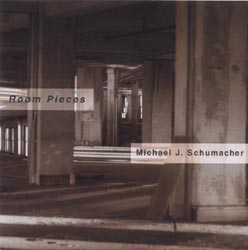
Michael Schumacher is usually classified as a composer of installation pieces. While certainly the case, with releases like this one he blurs the boundaries and, arguably, transcends them. Recordings of such music are problematic on their face. So much is necessarily lost (including one of their central reasons for being) that they often result in pale facsimiles lacking any nodes of interest. It's a great strength of Schumacher's work that, though the listener is obviously missing the subtle thrill of being able to walk through and around this music, it stands up perfectly well on its own and, indeed, easily compares favorably with the best of contemporary electronic music.
The first disc of this 2-cd set is given over entirely to the 76-minute "Room Piece XI." In his notes, Julian Cowley likens it to an orrery, an early mechanical model of the solar system. It's an apt description, though I'm inclined to think more of an elaborate Calder mobile, where an array of precisely laid sounds take on an infinity of guises depending on the context in which they're heard. Many of the sounds have recognizable origins (notes from the piano, a guitar, percussion), others are abstract electronics. They repeat in very loose loops, loose enough that the listener doesn't recognize them as such, giving one the odd mixture of familiarity and newness. The pace is quite relaxed, an amble through a fascinating space with no particular goal in mind. It's a lovely, mysterious and evocative work.
Disc two contains four shorter compositions. 'Piece in 3 Parts' samples improvisations by violinist Jane Henry and percussionist Tim Barnes, creating a comparatively hyperactive work that begins as highly pitched and dense, the sounds flitting back and forth like insects in a rainforest. Midway through, it descends enticingly toward darker, more aqueous territory; very riveting. The work reads complete as presented and is actually difficult to imagine as an installation piece, unless the sudden shift in mood is meant to correspond with a transition between rooms. Whatever the case, it's quite impressive. The first "Still" utilizes bowed sounds from cellist Charles Curtis, resulting in a soft, hazy scrim, at once complex and gauzy. "Untitled," from 1999, stands out in this collection for its louder, more aggressive and less transparent qualities. Its immense thrummings and speaker-shaking volume places it comfortably in the niche label founder Phill Niblock has often occupied, that of feeling as though situated in the core of some gigantic engine. The second "Still," which closes out the set, has a soft, near-regular pulse underlying what seem to be plucked string sounds as well as silvery, electronic tweets and chirps. As with other pieces here, there are subtle allusions to the natural world, never overt but always hovering at the edge of the listener's consciousness. It all makes for an extremely satisfying, occasionally luxuriant walk through Schumacher's unique sound-world, as easy to listen to intently as to have on as part of your own room's atmosphere.
Comments and Feedback:



More Recent Reviews, Articles, and Interviews @ The Squid's Ear...


|

